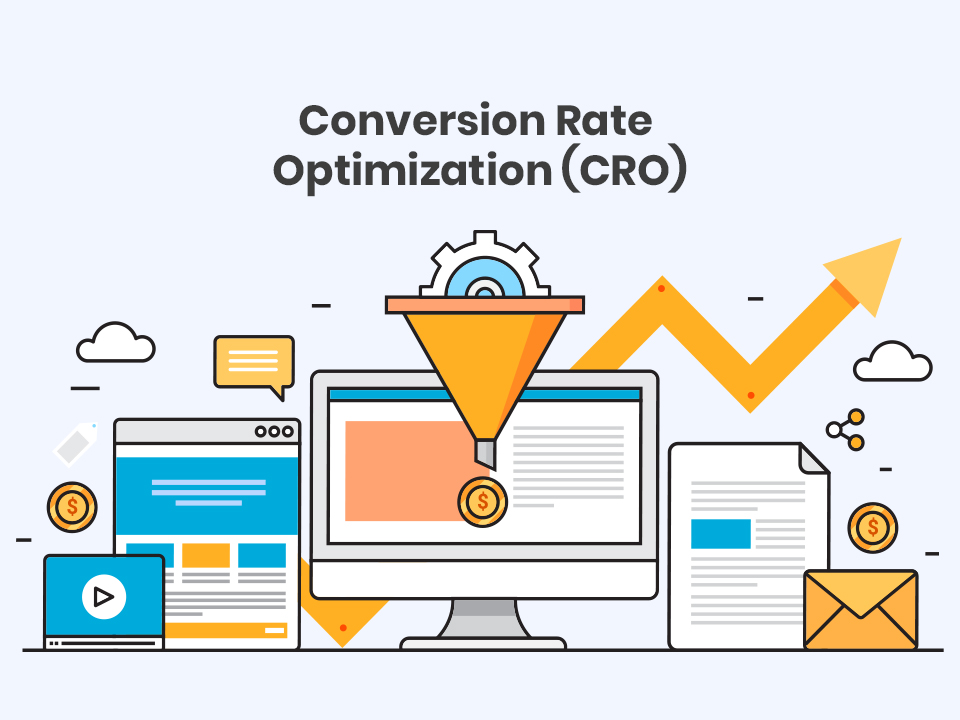Are you eager to enhance your online presence and skyrocket your business's success? Look no further! In this comprehensive guide, we'll explore the art and science of Conversion Rate Optimization (CRO) and how it can be a game-changer for your website's performance. Are you in search of a seasoned expert to guide you through this transformative process? Consider partnering with a dedicated conversion rate optimization consultant.
CRO, the process of refining your website to boost conversions, is more crucial than ever in today's competitive digital landscape. As online consumers become savvier, ensuring a seamless user experience and optimizing your site's layout and content are paramount. A conversion rate optimization consultant can provide invaluable insights tailored to your business, implementing strategies that resonate with your target audience and enhance user engagement.
TLDR
- CRO is a data-driven approach to improving website effectiveness
- CRO strategies involve analyzing user behavior and implementing changes
- CRO tools and software enable data-driven decisions
- Key steps for effective CRO include analyzing user data, conducting user research, A/B testing and experimentation, and conversion funnels and rate optimization.
Understanding CRO Marketing
Let's begin by understanding what CRO marketing is and its importance in our overall marketing strategy.
CRO, or Conversion Rate Optimization, refers to the process of improving the percentage of website visitors who complete a desired action, such as making a purchase or filling out a form.
Defining CRO
We can start by explaining what CRO marketing is and how it can benefit businesses. Conversion Rate Optimization (CRO) is a data-driven approach to improving the effectiveness of a website or landing page in converting visitors into customers or taking desired actions.
CRO strategies involve analyzing user behavior, identifying areas of improvement, and implementing changes to optimize the conversion process. CRO tools, such as heatmaps, A/B testing platforms, and user feedback tools, help in gathering data and insights for effective optimization.
CRO best practices include conducting thorough research, creating compelling and relevant content, optimizing website design and navigation, and ensuring a seamless user experience. CRO techniques involve testing different elements, such as headlines, call-to-action buttons, forms, and images, to determine the most effective versions.
CRO case studies and success stories provide real-world examples of how businesses have increased their conversions through optimization efforts. CRO implementation requires continuous monitoring and analysis of key metrics, such as conversion rates, bounce rates, and average session duration.
CRO testing involves conducting experiments to validate hypotheses and make data-driven decisions. Overall, CRO marketing helps businesses maximize their website's potential, improve customer experience, and drive more conversions.
The Importance of CRO
For businesses, understanding the importance of CRO marketing is crucial in order to optimize their website's performance and increase conversions. Conversion rate optimization strategies, also known as CRO, involve implementing various techniques and best practices to improve the effectiveness of a website or landing page in converting visitors into customers. CRO is not just limited to e-commerce websites, but also applicable to mobile apps, landing pages, and lead generation efforts. With the right CRO tools and software, businesses can analyze user behavior, conduct A/B testing, and make data-driven decisions to enhance their conversion rates. CRO case studies often highlight the success stories of companies that have implemented effective CRO strategies, providing valuable insights for others to learn from. Whether it's an e-commerce website, a mobile app, or a SaaS company, CRO can play a crucial role in driving growth and maximizing conversions.
| CRO Marketing | Importance | Benefits |
|---|---|---|
| Conversion optimization techniques | Increase conversion rates | Improve website performance |
| CRO best practices | Enhance user experience | Boost revenue |
| Conversion rate optimization strategies | Optimize marketing campaigns | Increase customer satisfaction |
| CRO case studies | Learn from successful implementations | Gain insights for improvement |
| CRO tools and software | Analyze user behavior | Make data-driven decisions |
Key Steps for Effective CRO
When it comes to effective CRO, there are several key steps that we need to consider.
First, analyzing user data allows us to gain insights into user behavior and identify areas for improvement.
Second, conducting user research helps us understand our target audience and their needs, allowing us to tailor our strategies accordingly.
Lastly, A/B testing and experimentation enable us to test different variations and optimize our website or landing page to enhance the user experience and ultimately drive conversions.

Analyzing User Data
Our team analyzes user data to identify key insights for effective CRO strategies. By understanding user behavior and conducting data analysis, we can optimize conversions and improve user engagement.
Here are five important aspects of analyzing user data:
User segmentation: Dividing users into specific groups based on demographics, behavior, or preferences allows for targeted marketing strategies.
Conversion funnels: Mapping out the steps users take from initial interaction to conversion helps identify areas for improvement and optimize the conversion process.
User journey analysis: Examining the entire user experience across different touchpoints helps identify pain points and opportunities for optimization.
Conversion rate optimization: Continuously testing and refining different elements on a website or landing page can improve the overall conversion rate.
User experience analysis: Evaluating the overall user experience helps identify areas where users may be encountering difficulties or frustration, leading to a better user experience and increased conversions.
Conducting User Research
We have identified several key steps for conducting effective user research in CRO marketing. Understanding user behavior and preferences is crucial for optimizing conversion rates. To gather valuable insights, it is important to target the right audience and collect user feedback through various methods such as usability testing, surveys and questionnaires, and user interviews. Market research and competitive analysis can also provide valuable information about user needs and expectations. Creating user personas can help in visualizing and understanding the target audience, while heatmap analysis can reveal patterns of user engagement on a website. By following these steps and utilizing user research techniques, CRO marketers can make data-driven decisions to improve conversion rates and enhance the user experience.
| Key Steps for Conducting User Research in CRO Marketing |
|---|
| 1. Understand user behavior and preferences |
| 2. Target the right audience |
| 3. Collect user feedback through various methods |
A/B Testing and Experimentation
One of the key steps for effective CRO is to conduct A/B testing and experimentation. A/B testing techniques allow us to compare different versions of a webpage or user experience to determine which one performs better in terms of conversion rates. This helps us optimize landing pages and make data-driven decisions to improve website performance.
Experimentation best practices involve testing variations of elements such as headlines, images, call-to-action buttons, and navigation menus. By measuring conversion rates and analyzing test results, we can gain insights into user behavior and understand what elements are most effective in driving conversions.
This allows us to implement conversion optimization strategies that resonate with our audience and ultimately lead to better results.
Optimizing User Experience
To achieve effective CRO, it's crucial to optimize the user experience by conducting thorough research and implementing data-driven strategies. Conversion optimization is the process of enhancing the performance of a website or landing page to increase the desired actions taken by users.
User centric design focuses on creating a website that meets the needs and preferences of the target audience. Website usability plays a vital role in ensuring that users can easily navigate and interact with the site. Conversion rate analysis and user behavior analysis help identify areas for improvement and understand user preferences.
Conversion funnel optimization and user journey mapping aid in streamlining the user experience and guiding users towards conversion. Conversion rate optimization techniques, such as A/B testing and personalization, can be utilized to enhance the website's performance. User interface optimization ensures that the design and layout of the website are intuitive and visually appealing.
Benefits of CRO Marketing
When it comes to CRO marketing, one of the key benefits is the ability to increase conversion rates. By optimizing your website or landing pages, you can improve the user experience and make it easier for visitors to take the desired action. This can lead to a higher number of conversions and ultimately, more sales or leads.
Additionally, CRO marketing can also result in improved ROI. By focusing on optimizing existing traffic and improving conversion rates, you can maximize the value of each visitor and get more out of your marketing efforts.
Increased Conversion Rates
The increased conversion rates achieved through CRO marketing can greatly benefit our business. By implementing conversion optimization techniques, conversion rate optimization strategies, and effective conversion rate tactics, we can boost our conversion rates and maximize our conversion potential.
Increasing website conversions is crucial for enhancing online conversions and improving our overall conversion rate. By following conversion optimization best practices and utilizing conversion rate improvement tips, we can optimize our website and ensure that our visitors are more likely to convert into customers.
With CRO marketing, we've the opportunity to increase our website's conversion rates and ultimately drive more sales and revenue for our business. It's essential that we focus on conversion rate optimization tips to ensure the success of our online marketing efforts.
Improved ROI
By implementing effective CRO marketing strategies, we can significantly increase our return on investment and maximize our business's profitability. Conversion optimization is a crucial aspect of achieving this goal. By focusing on conversion rate optimization techniques, we can improve the percentage of website visitors who become customers. This ultimately leads to increasing revenue and boosting sales conversions.
CRO strategies and tactics involve enhancing the customer experience to encourage more conversions. By optimizing the design and layout of our website, streamlining the checkout process, and implementing conversion optimization best practices, we can create a seamless and user-friendly experience for our customers.
Furthermore, studying CRO case studies can provide valuable insights and inspiration for our own ROI improvement strategies. These case studies offer real-world examples of how businesses have successfully implemented CRO techniques to achieve significant improvements in their ROI.
Frequently Asked Questions
What Are the Common Challenges Faced When Implementing CRO Marketing Strategies?
Addressing CRO marketing difficulties requires overcoming conversion rate obstacles, implementing effective CRO strategies, and maximizing conversions. Common roadblocks in CRO include optimization hurdles and challenges in CRO implementation. Strategies for CRO success involve tackling these obstacles head-on.
How Long Does It Typically Take to See Results From CRO Marketing Efforts?
Factors affecting the timeline of CRO marketing results include the learning curve of implementation, website traffic, and data analysis. Case studies show quick results can be achieved by leveraging user feedback and optimizing for different industries.
Are There Any Specific Industries or Businesses That Can Benefit the Most From CRO Marketing?
Industries like retail, e-commerce, technology, services, SaaS startups, finance, healthcare, travel, non-profits, and education can benefit from CRO marketing. It helps optimize conversions, improve user experience, and generate higher ROI.
What Are Some Common Misconceptions About CRO Marketing?
Top misconceptions about CRO marketing include the belief that it's only for certain industries or that results are immediate. However, CRO can benefit any business and requires time and effort to see progress.
What Are the Key Metrics and Tools Used to Measure the Success of CRO Marketing Campaigns?
To measure the success of CRO marketing campaigns, we use key metrics like conversion rate, A/B testing, heatmaps, funnel analysis, and user experience. We also track conversion goals, optimize landing pages, and conduct split testing for data analysis.






